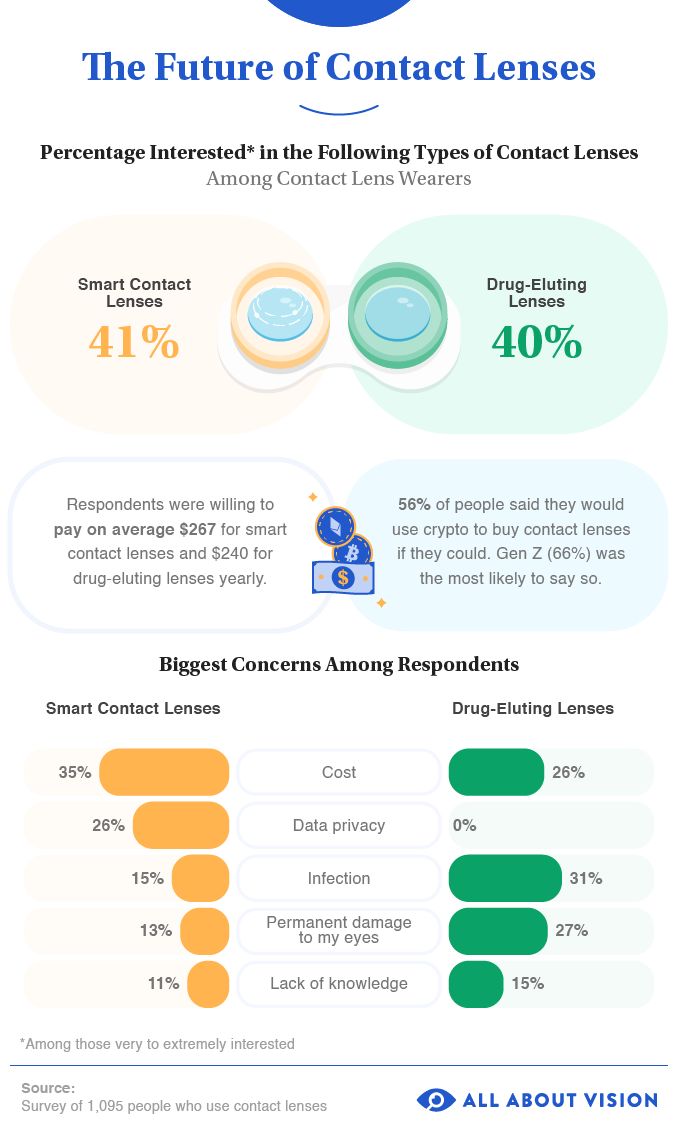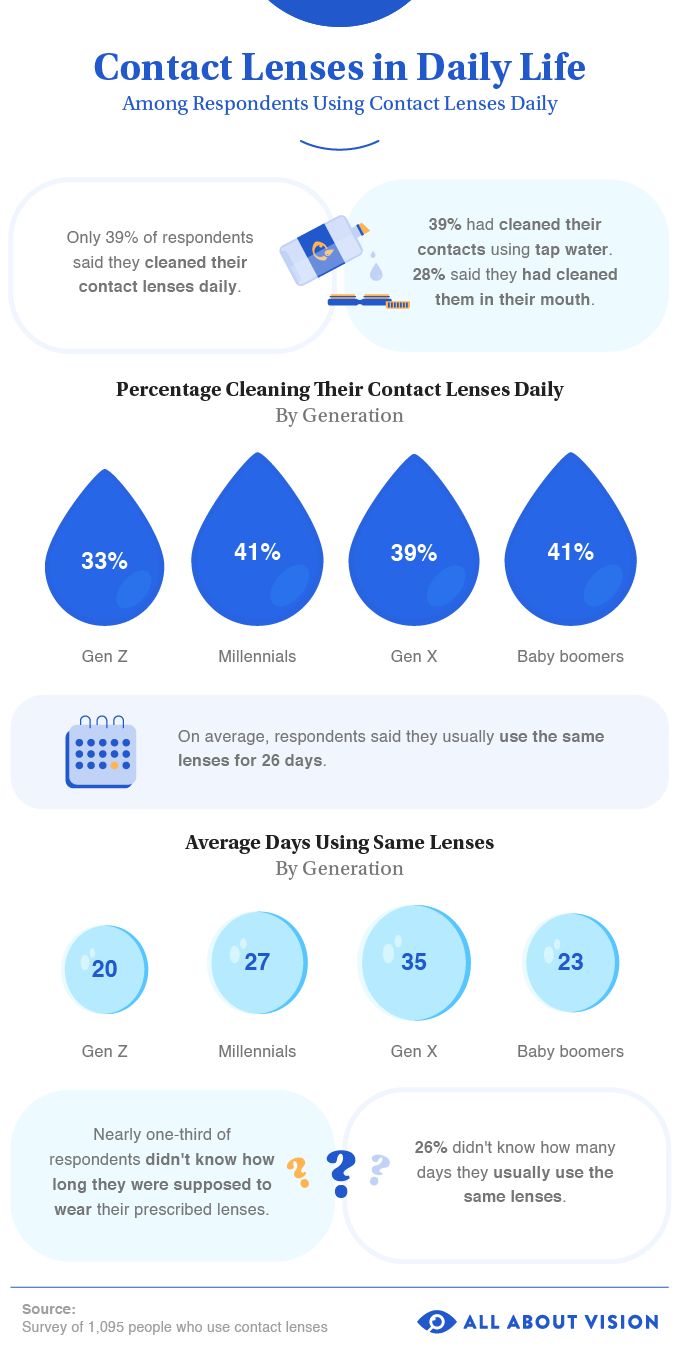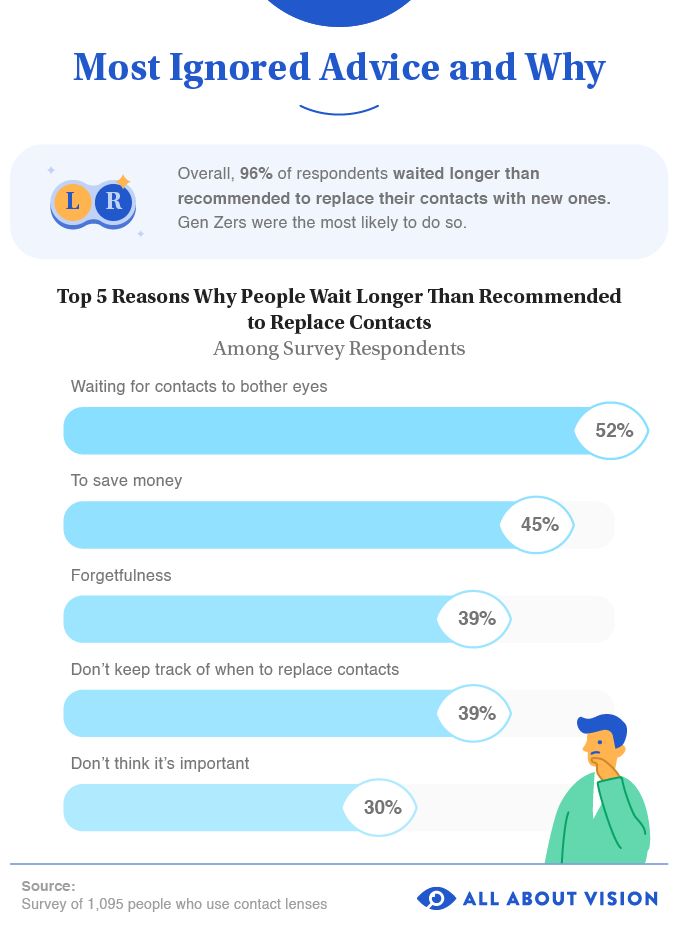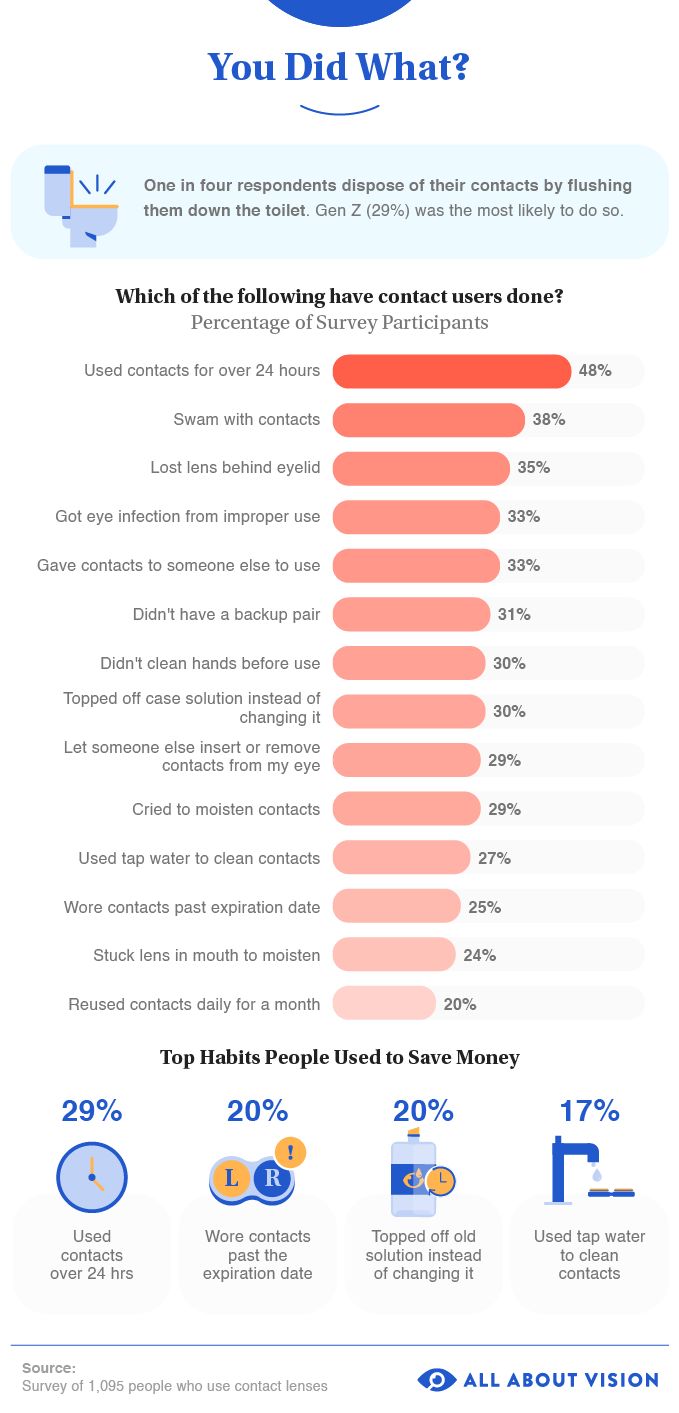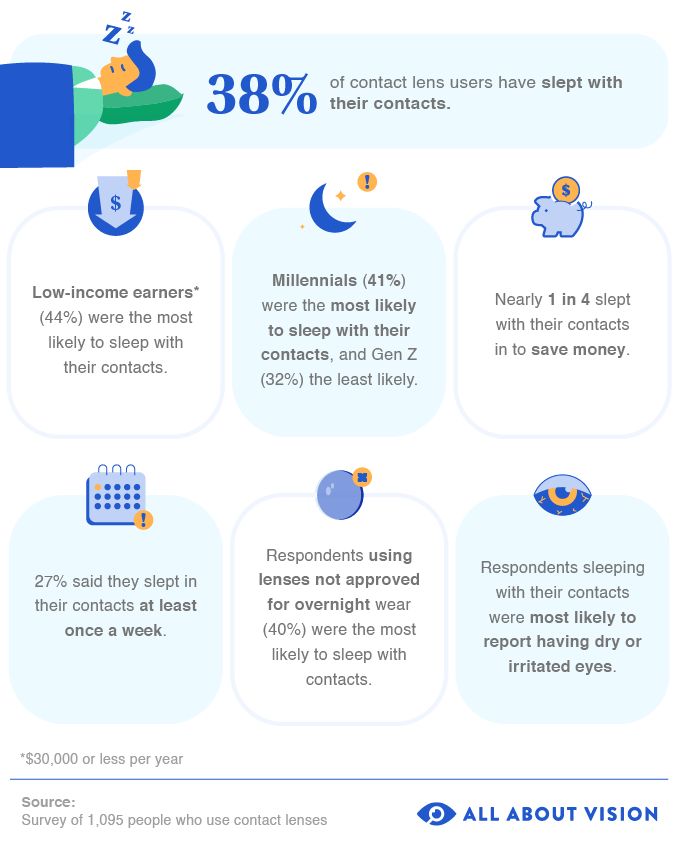What are the most common bad habits of contact lens wearers?
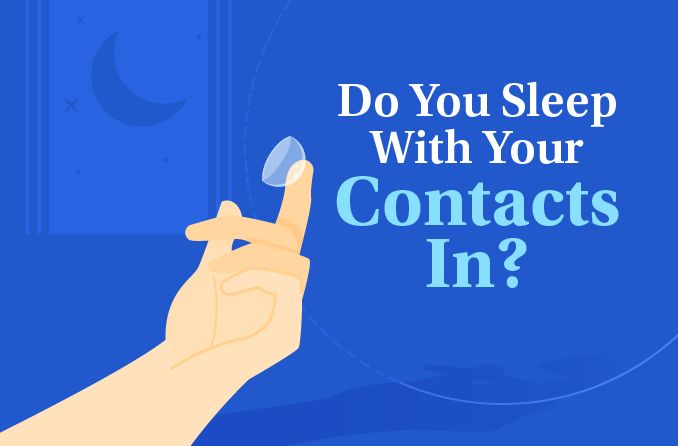
Low-Income Earners (44%) Are Most Likely To Sleep With Their Contacts In
While contact lenses can be incredibly convenient, they require regular care and replacement. This upkeep can feel tedious to users, but it can also be quite expensive. Cost can make proper contact lens care unattainable for many. To save time and money, people often wear the same pair of contact lenses for much longer than they should, which increases their risk of infection and other eye-related issues.
Aside from the cost of frequent replacement, additional expenses like cleaning solutions and carrying cases are obstacles for many people. Having limited access to eye care supplies might be one of the reasons why people wear contact lenses for extended periods or choose to sleep with their contact lenses in — one of the biggest mistakes users make.
A recent survey of 1,095 contact lens users revealed that low-income earners are more likely to sleep with their contact lenses than people who earn more than $30,000 per year. If you wear contacts or are considering trying them, read on to learn more about the most common habits of contact lens wearers and what you can do to ensure a positive experience.
Key takeaways
40% of contact lens users are ready for drug-eluting contact lenses.
96% of contact lens users wait longer than recommended to replace their contacts. Nearly 1 in 2 contact wearers do it to save money.
Almost one-third of contact users don’t know how long they’re supposed to wear their prescribed lenses.
38% of contact users sleep with their contacts in; about 1 in 4 do it to save money.
Technologies of the future
As if the existence of regular contact lenses wasn’t impressive enough, medical technology giants like Mojo are working on developing smart contact lenses. These contacts will provide critical information to users while they’re performing activities that require significant concentration –– like skiing on a slippery slope or giving a presentation.
Smart contact lenses’ micro-LED display capabilities will provide users with real-time information, making it significantly easier to stay focused without looking at a screen. However, every fresh idea comes with questions and concerns. Given that smart contacts are an extremely new and conceptual idea, people are wary of high costs, potential infection, irreversible damage to the eyes and data privacy.
RELATED READING: Smart contacts coming with AR, health monitoring and more
Additionally, the FDA has recently approved drug-eluting contact lenses, which are contact lenses that dispense drugs directly into the eye. This idea is decades old, but it has only come to fruition in more recent times. The benefits of drug-eluting contacts would be endless, especially for patients who suffer from eye diseases, allergies and complications like glaucoma.
Patients with glaucoma are required to get frequent eye injections, and many of them avoid visiting the eye doctor for this reason. Drug-eluting contact lenses would be a replacement for the eye injections many patients with this condition fear. These contacts would highly benefit patients, and they may also help providers complete their job more efficiently.
Drug-eluting contact lenses could also be a possible solution for non-compliant patients, as they would guarantee the needed drugs are properly administered. Additionally, drug-eluting contacts would replace eye drops, which have long been the standard method for delivering eye medications. Despite all of these benefits, the concept of drug-eluting contact lenses is still fairly novel.
While 40% of contact lens users are ready for drug-eluting contact lenses, many users and providers alike have reservations about their usage. With limited knowledge about drug-eluting lenses, people aren’t as open to trying them as they could be. The biggest concerns about drug-eluting contact lenses are potential infections, permanent eye damage and cost.
Are your contact lens habits good enough?
You might have worn contact lenses for years, but how are your eye care habits? Visiting the eye doctor is supremely important if you want to have a positive experience with contact lenses, but there are many steps you can take at home to avoid problems.
Contact lenses should be cleaned before and after each use and replaced as frequently as the manufacturer recommends for the best eye health. People should never wear lenses longer than prescribed, as this habit may lead to eye issues like an infection.
Almost one-third of our survey respondents admitted not knowing how often they should replace their contact lenses. Because not all contact lenses are the same, consult with your eye doctor about the recommended wearing period for your specific lenses. On average, respondents reported wearing the same lenses for 26 days.
An alarming 39% of respondents had used tap water to clean their contact lenses, and 28% had cleaned them in their mouths. Only 39% of respondents cleaned their lenses daily. Before handling contact lenses, remember to wash your hands thoroughly and ensure you’re working on a clean surface. Also, use a reputable cleaning solution to disinfect and store your contact lenses.
Why not follow the advice?
It might come as no surprise that the most ignored advice regarding contact lenses is replacing them at the right time. We found that 96% of respondents waited longer than recommended to replace their contacts, with Gen Zers most likely to do so.
There’s a reason why eye physicians recommend timely replacement of your contact lenses. If you don’t replace your contacts as directed, it can lead to eye discomfort or other complications.
Save yourself the trouble, and stick to your replacement schedule — even if your current lenses cause no major discomfort: 52% of respondents waited until their contact lenses became troublesome before considering replacement. To protect your eyesight and keep your eyes healthy, you shouldn’t delay.
Bad habits to avoid
If you wear contact lenses, there are several things you should avoid doing to steer clear of potential eye issues. The worst habits for contact lens wearers are wearing lenses for longer than 24 hours, swimming with them and not properly washing your hands before handling them.
Almost 50% of survey respondents admitted using the same contact lenses for over 24 hours. Thirty-eight percent have also swum with their contacts. If you’re planning on going for a swim, avoid wearing your contact lenses. Swimming with your contact lenses increases your risk of infection, as the lenses can absorb water and trap bacteria in your eyes.
Some contact users also admitted to not replacing their lenses as they should: 1 in 4 respondents reported wearing their contacts past the lenses’ expiration date. Among all the bad habits contact users reported, wearing lenses for more than 24 hours was the habit most practiced to save money, followed by wearing them past the expiration date. If you often forget to replace your contacts accordingly, extended wear contact lenses might be an option worth exploring.
Additionally, 38% of contact lens users have admitted to sleeping with their contacts. Based on our findings, millennials (41%) were most likely to do this. Even though removing your contact lenses after a long day can be bothersome, you should make this a top habit. Aside from infections, sleeping with your contact lenses can cause corneal ulcers. An extra step before bed can spare you lots of trouble! On this note, Gen Zers were the least likely to sleep with their contact lenses.
Those who wear lenses not designed for overnight use were the most likely to sleep with their contacts. Unsurprisingly, these respondents were the most likely to report dryness and irritation in the eyes. These missteps are major causes of eye issues, but they can be easily avoided by developing proper habits.
How well are we taking care of our eyes?
Wearing contact lenses can be intimidating at first since you might not be used to coming in such close contact with your eyes. If you’re a long-time contact lens wearer, you might have become too comfortable about regularly visiting your eye care provider and adequately caring for your contact lenses. Following your provider’s instructions, establishing a strict cleaning routine and staying updated with new developments in the contact lens world can help make your glasses-free lifestyle even more comfortable and safe.
Methodology
For this project, we surveyed 1,095 contact lens wearers. Among them, 49% were men, 50% were women and 1% identified as nonbinary. 22% belonged to Generation Z, 47% to millennials, 20% to Generation X and 11% to baby boomers.
To help ensure that all respondents took our survey seriously, they were required to identify and correctly answer an attention-check question. Survey data has certain limitations related to self-reporting. The margin of error is plus or minus 3% with a 95% confidence interval.
About All About Vision
All About Vision is dedicated to providing accessible information and solutions for all aspects of vision and eye health.
Fair Use Statement
If you wear contact lenses or know someone who does, feel free to share these findings with them for non-commercial purposes only. We just kindly ask that you provide links back to our work.
Page published on Tuesday, June 14, 2022
